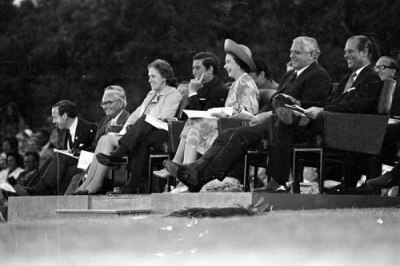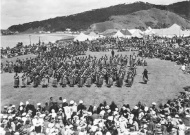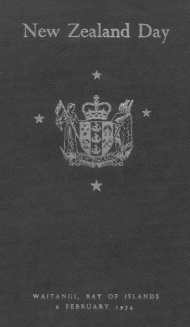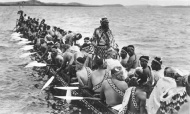Articles
Waitangi Day

Every year on 6 February, New Zealand marks the signing of the Treaty of Waitangi in 1840. For most people, Waitangi Day is a holiday; for many, and especially for Māori, it is a time for reflecting on the Treaty and its place in modern New Zealand.
-
Page 2 – The first Waitangi Day
Governor-General Lord Bledisloe gifted the Treaty House and grounds at Waitangi to the nation in 1932. Two years later there were celebrations at Waitangi to mark the date of
-
Page 3 – Waitangi Day 1940s-1950s
From the 1940s the Treaty and Waitangi began to find a place in the national consciousness. For most New Zealanders, they were of historical interest only.
-
Page 4 – Waitangi Day 1960s
The Waitangi Day Act 1960 declared 6 February to be Waitangi Day; a national day of thanksgiving in commemoration of the signing of the Treaty of Waitangi.
-
Page 5 – Waitangi Day 1970s
Waitangi Day, a public holiday from 1974, briefly became New Zealand Day in the 1970s. Increasingly, it became a focus for Māori protest activities.
-
Page 6 – Waitangi Day 1980s
The 1980s brought changes in the way Waitangi Day was marked officially, as well as growing Māori protest.
-
Page 7 – Waitangi Day 1990s
In the 1990s Waitangi Day events became a focus for protests about sovereignty.
-
Page 8 – Waitangi Day in the 21st century
Waitangi Day in the 21st century has been linked more closely with New Zealand identity, and events have expanded beyond Waitangi itself. Protests have continued, and
-
Page 9 – The Treaty House
The Treaty House is New Zealand's most-visited historic building. In 1932 Governor-General Lord Bledisloe gifted it to the nation. The house and grounds have been the focus of
-
Page 10 – Further information
Links and further reading about Waitangi Day
The Treaty in brief

The Treaty of Waitangi is New Zealand’s founding document. It takes its name from the place in the Bay of Islands where it was first signed, on 6 February 1840. The Treaty is an agreement, in Māori and English, that was made between the British Crown and about 540 Māori rangatira (chiefs).
- Page 1 - The Treaty in briefThe Treaty of Waitangi is New Zealand’s founding document. It takes its name from the place in the Bay of Islands where it was first signed, on 6 February 1840. The Treaty is an
Treaty timeline

See some of the key events between 1800 and 1849 relating to the Treaty of Waitangi.
- Page 3 - Treaty events 1900-49Discover some of the key events between 1900 and 1949 relating to the Treaty of
Biographies
-
 Kirk, Norman Eric
Kirk, Norman Eric
In 1972 Norman Kirk broke National’s 12-year-long grip on the Treasury benches and became Labour’s first New Zealand-born PM.
Read more...
Related keywords
- royalty
- waitangi
- 1970s
- queen elizabeth
- norman kirk
- treaty of waitangi
- waitangi tribunal
- roadside stories
- protest
- public holidays
- race relations
- hikoi
- 1980s
- flags
- navy
- ngapuhi
- treaty house
- poster
- sesquicentenary
- treaty claims
- MPs
- prime ministers
- labour party
- springboks
- nuclear free
- national identity
- police
- new zealand day
- centennial
- cartoon
- apirana ngata
- haka
- centennial exhibition
- helen clark
- 1960s
- lord cobham
- royal tours
- 1950s
- matiu rata
- charles bledisloe
- rua kenana
- wiremu pomare
- tahupotiki wiremu ratana
- timeline
- james busby
- government
- william hobson
-
Main image: Royal family at Waitangi, 1974
Queen Elizabeth, Prince Charles, the Duke of Edinburgh, and Prime Minister Norman Kirk at Waitangi on 6 February 1974
















